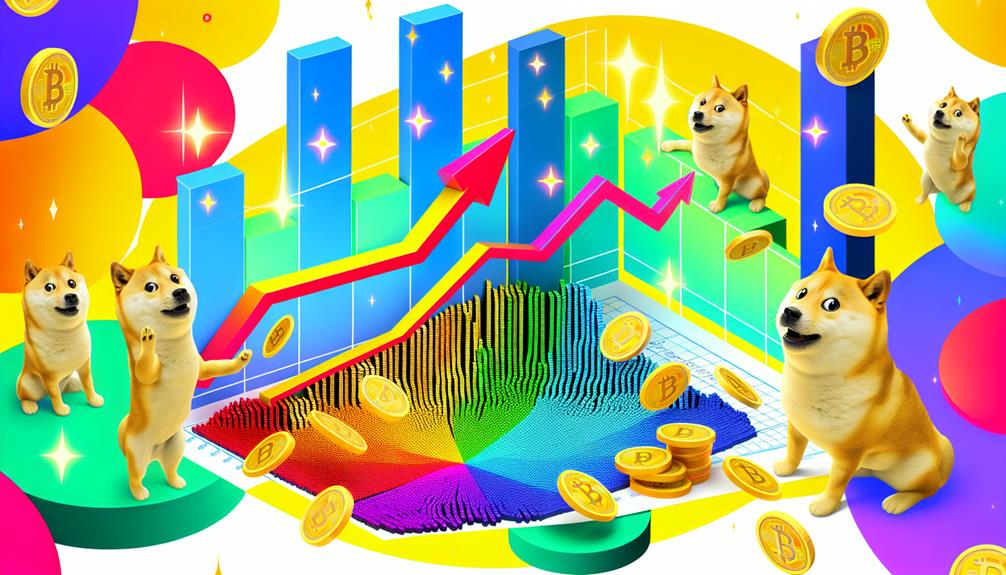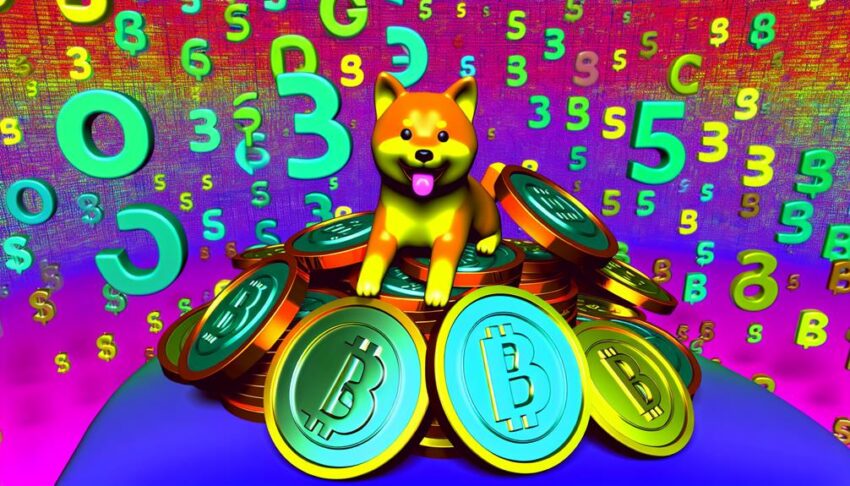Did you know that as of October 2023, there are approximately 140 billion Dogecoins in circulation? This striking figure illustrates Dogecoin's unique inflationary model, where an unlimited supply is generated through consistent mining. But what does this ongoing increase in supply mean for the cryptocurrency market and for potential investors like you? Understanding the implications of such a vast circulation could greatly influence your approach to Dogecoin and its future.
Dogecoin Supply Overview

Dogecoin's supply structure is unique compared to many other cryptocurrencies, as it features an inflationary model rather than a capped supply. This means that there isn't a maximum limit to the number of Dogecoins that can exist, which greatly impacts its mining process and overall market dynamics. In contrast to Bitcoin, which has a fixed supply of 21 million coins, Dogecoin's inflationary model allows for a continuous addition of new coins into circulation.
Dogecoin mining plays an essential role in this supply structure. Miners validate transactions and, in return, receive newly minted Dogecoins as rewards. The current block reward is set at 10,000 Dogecoins per mined block, and with blocks being produced approximately every minute, this results in a steady influx of new coins. As a consequence, the total supply of Dogecoin increases annually, theoretically providing a buffer against scarcity-driven price spikes.
Market demand also influences the effective supply of Dogecoin available to investors and users. If demand surges while the inflationary supply remains stable or rises slowly, the price of Dogecoin may experience upward pressure. Conversely, if demand wanes, the continuous addition of new coins could lead to downward price trends, highlighting the delicate balance between supply and demand in the crypto market. Understanding this relationship is essential for anyone looking to navigate the complexities of investing in Dogecoin or engaging in its mining process.
Inflationary Model Explained
In an inflationary model, the supply of a cryptocurrency increases over time, which can greatly influence its value and market behavior. Dogecoin employs a unique inflation mechanics approach, where new tokens enter circulation continuously. Unlike Bitcoin, which has a capped supply, Dogecoin's inflation model allows for a steady introduction of new coins, effectively making it an ever-growing asset.
This ongoing token distribution creates a dynamic market environment. When you consider supply and demand, an increase in the total supply can lead to dilution of value per individual token, especially if demand doesn't keep pace with this growth. However, Dogecoin's inflationary nature also has its advantages. It encourages spending rather than hoarding, as holders know that their coins will be part of a larger pool over time. This can foster a vibrant ecosystem where transactions are frequent, contributing to its overall utility.
Moreover, the predictable issuance of new coins can lead to a sense of stability within the community. You can anticipate how many new Dogecoins will be released each year, allowing for strategic planning regarding investments and transactions. This operational transparency can bolster user confidence, potentially attracting more participants into the market.
Historical Supply Growth

Throughout its history, the supply of Dogecoin has experienced significant growth, reflecting its unique inflationary model. Unlike many cryptocurrencies that impose a supply cap, Dogecoin's approach allows for continual issuance through its mining process. This perpetual inflation is intended to encourage spending rather than hoarding, creating an environment where the currency remains active in circulation.
Key aspects of Dogecoin's historical supply growth include:
- Unlimited Supply: Without a maximum supply limit, Dogecoin's design promotes ongoing mining and issuance.
- Mining Rewards: Miners receive a consistent reward for validating transactions, which contributes to an ever-increasing supply.
- Community Engagement: The growth has been bolstered by a vibrant community that actively participates in the mining process and promotes the currency.
The mining process, which utilizes the Scrypt algorithm, facilitates the creation of new Dogecoins approximately every minute. This continual generation contrasts sharply with cryptocurrencies that limit total supply, like Bitcoin, which has a fixed cap of 21 million coins. Consequently, Dogecoin's inflationary model results in a steady increase in the total supply, encouraging users to utilize their coins rather than stash them away.
Current Circulating Supply
As of October 2023, the current circulating supply of Dogecoin is approximately 140 billion coins, a figure that continues to grow due to its inflationary design. This characteristic means that new coins are regularly introduced into the market, impacting supply dynamics and valuation. Unlike Bitcoin, which has a capped supply of 21 million coins, Dogecoin's inflationary model allows for an unlimited number of coins to be mined.
The supply dynamics of Dogecoin are critical for understanding its market behavior. As more coins enter circulation, the potential for price dilution exists, especially if demand doesn't match the increasing supply. Consequently, tracking how Dogecoin's circulating supply correlates with market trends is essential.
Currently, the inflation rate for Dogecoin is around 5 billion new coins annually, which translates to roughly 5% of the existing supply. This consistent issuance can affect investor sentiment and market stability. As you observe market trends, you'll notice that periods of heightened trading activity often coincide with larger fluctuations in the circulating supply, further emphasizing the relationship between supply and demand.
Implications for Investors

The growing circulating supply of Dogecoin directly influences investment strategies and market behavior. As an investor, understanding these implications is essential for maneuvering the volatile landscape of cryptocurrencies. With no maximum supply cap, Dogecoin's inflationary nature can affect market sentiment and subsequently your investment approach.
Here are three key considerations:
- Long-term Holding vs. Short-term Trading: With the continuous increase in supply, you might lean towards long-term holding strategies, anticipating that mainstream adoption will eventually drive value, or you may opt for short-term trading to capitalize on price fluctuations.
- Market Sentiment Analysis: The perception of Dogecoin within the cryptocurrency community can greatly impact its price. As an investor, staying attuned to social media trends and community discussions can help you gauge sentiment, informing your decisions.
- Diversification Strategies: Given Dogecoin's unique characteristics, integrating it into a diversified portfolio can help mitigate risks. You might consider balancing your Dogecoin investments with other cryptocurrencies or traditional assets to stabilize potential volatility.
Frequently Asked Questions
How Is Dogecoin Different From Bitcoin in Terms of Supply?
Dogecoin's inflationary model allows for an unlimited supply, contrasting Bitcoin's capped limit. This difference affects transaction speed, with Dogecoin processing transactions faster, making it more suitable for everyday transactions compared to Bitcoin's slower confirmation times.
Can Dogecoin's Supply Be Altered by Developers?
You'll find that developer control over Dogecoin's supply management is limited. Unlike Bitcoin, its inflationary model lacks a cap, but significant changes to the supply would require community consensus, not just developer decisions.
What Happens to Dogecoin Supply During Market Crashes?
During a market crash, like in March 2020, you'll see Dogecoin's supply dynamics shift. Increased selling pressure can lead to instability, affecting prices and investor confidence, highlighting the importance of understanding market stability in cryptocurrency.
Is Dogecoin Mined Differently Than Other Cryptocurrencies?
Yes, Dogecoin's mining process differs from others; it utilizes Scrypt hash algorithms, which are less resource-intensive than Bitcoin's SHA-256. This allows more accessible mining, encouraging broader participation in the Dogecoin network.
How Does Dogecoin's Supply Affect Its Price Volatility?
Dogecoin's supply dynamics play an essential role in its price volatility. As you analyze market psychology, you'll see that fluctuations in supply can greatly influence investor sentiment, leading to rapid price changes in response to perceived scarcity or abundance.
Conclusion
In summary, understanding Dogecoin's unique inflationary model is essential for investors. With approximately 140 billion coins in circulation and an annual increase of about 5 billion, the continuous supply growth could lead to price dilution if demand doesn't keep pace. This theory highlights the importance of monitoring market dynamics closely. As you navigate the Dogecoin landscape, consider both the potential rewards and risks associated with its ever-increasing supply, ensuring you're making informed investment decisions.
